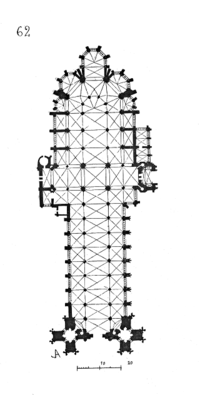Saint-Ouen Abbey, Rouen
| Saint-Ouen Abbey | |
|---|---|
| Saint Owen Abbey Marie", 3 tons (1651); "Julie Marcelle", 2135kg (1887)[6] | |
| Administration | |
| Archdiocese | Rouen |
| Clergy | |
| Archbishop | Dominique Lebrun |
| Laity | |
| Organist/Director of music | Marie-Andrée Morisset-Balier[7] |
| Organist(s) | Jean-Baptiste Monnot[8] |
Building details | |
 | |
| General information | |
| Location | Rouen, Normandy |
| Height | |
| Antenna spire | 82m |
Saint-Ouen Abbey, (


(view as a 360° interactive panorama)
The Abbey

The current church building was originally built as the abbey church of Saint-Ouen for the Benedictine Order, beginning in 1318 and interrupted by the Hundred Years' War and sacked and badly damaged during the Harelle. It was completed in the 15th century in the Flamboyant style.
The foundation of Saint-Ouen Abbey has been variously credited, among others, to
The history of the abbey, on record from the 1000, is unremarkable; a list of abbots is in Gallia Christiana XI, 140.[12] The fourth abbot, Nicolas (r. 1042–1092) was the first cousin of William the Conqueror, and supplied ships and men for the Norman Conquest.[13][14]
In 1660 the monastery was united to the Congregation of Saint Maur, and when suppressed, in 1794, the community numbered twenty-four. The abbey buildings were confiscated at the time of the French Revolution and were subsequently occupied by the Town Hall of Rouen.[15]
Architecture
The church is 137 m in length under 33 m high vaults. The central crossing is surmounted by an unusual lantern-style tower similar to that at Ely Cathedral in England. The tower was completed in the Flamboyant style.
The well-preserved stained glass of the nave dates to the 15th and 16th centuries, and features jewel tones among panels of clear and frosted white glass. These materials allow more light to filter into the nave, creating a brighter interior than is typical of Gothic churches. Despite the use of Flamboyant tracery in the aisles, triforium, and clerestory, the nave maintains a conservative appearance through the use of compound piers, trumpet bases, and capitals which helps maintain harmony throughout the edifice.
The west façade was never completed during the Middle Ages. The present structure was constructed between 1846 and 1851 in a Neo-Gothic style that bears little resemblance to the original Late Gothic designs.
- Architectural Details
Organ

The church contains a large four-manual pipe organ built in 1890 by Aristide Cavaillé-Coll. This instrument is considered to be one of the most important organs in France, and is notable for its powerful 32' Contre-bombarde. The organ stands unaltered and thus is one of the few of his works to speak with its original voice.
|
|
|
|
| ||||||||||||||||||||||||||||||||||||||||||||||||||||||||||||||||||||||||||||||||||||||||||||||||||||||||||||||||||||||||||||||||||||||||||||
- Couplers: Tirasse G.O., Tirasse Pos., Tirasse Réc., Appel G.O., Pos./G.O., Réc./G.O., Bomb./G.O., Pos./Réc., Bomb./Réc., Oct. gr. G.O., Oct. gr. Réc./G.O., Oct. gr. Réc., Oct. aiguë Réc., Anches Péd., Anches G.O., Anches Pos., Anches Réc., Anches Bomb., Trémolo Réc., Expression Réc.
Notes
- ISBN 978-0-19-866262-4.
- ^ "Example of the use of this spelling". Archived from the original on 2016-05-09. Retrieved 2016-04-26.
- ^ Walcott, Mackenzie Edward C. (1860). "Example of the use of this spelling".
- ^ "French article about the church and its bells". 31 March 2016.
- ^ Base Mérimée: IA00021986, Ministère français de la Culture. (in French)
- ^ "French article about the church and its bells". 31 March 2016.
- ^ "Article on the nomination of new assistant organist (in French)". Archived from the original on 2016-04-29. Retrieved 2016-04-22.
- ^ "Article on the nomination of new assistant organist (in French)". Archived from the original on 2016-04-29. Retrieved 2016-04-22.
- ISBN 978-0-19-866262-4, retrieved 2020-06-28
- ^ Walcott, Mackenzie Edward C. (1860). The Ministers and Abbey Ruins of the United Kingdom: Their History, Architecture, Monuments, and Traditions; with Notices of the Larger Parish Churches and Collegiate Chapels. London: E. Stanford. p. 127.
- ^ "Our Patron Saint | St. Owen Catholic Church | Bloomfield Hills, Michigan". 2016-05-09. Archived from the original on 2016-05-09. Retrieved 2020-06-28.
- ^ "Chartes originales antérieures à 1121 conservées en France". 10 June 2010.
- ISBN 978-2-902685-43-1
- ^ van Houts, Elisabeth (1987), "The ship list of William the Conqueror", Anglo-Norman Studies, X
- ^ Hudleston, Gilbert Roger (1912). . Catholic Encyclopedia. Vol. 13.
Bibliography
- Davis, Michael T. and Linda Elaine Neagley. "Mechanics and Meaning in the Plan Designs of Saint-Urbain, Troyes and Saint-Ouen, Rouen," Gesta 39 (2000): 161-182. https://www.jstor.org/stable/767144











